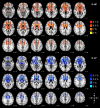Reduced frontal white matter microstructure in healthy older adults with low tactile recognition performance
- PMID: 34083614
- PMCID: PMC8175740
- DOI: 10.1038/s41598-021-90995-w
Reduced frontal white matter microstructure in healthy older adults with low tactile recognition performance
Abstract
The aging of the nervous system is a heterogeneous process. It remains a significant challenge to identify relevant markers of pathological and healthy brain aging. A central aspect of aging are decreased sensory acuities, especially because they correlate with the decline in higher cognitive functioning. Sensory and higher cognitive processing relies on information flow between distant brain areas. Aging leads to disintegration of the underlying white matter tracts. While this disintegration is assumed to contribute to higher cognitive decline, data linking structural integrity and sensory function are sparse. The investigation of their interrelation may provide valuable insight into the mechanisms of brain aging. We used a combined behavioral and neuroimaging approach and investigated to what extent changes in microstructural white matter integrity reflect performance declines in tactile pattern recognition with aging. Poor performance in older participants was related to decreased integrity in the anterior corpus callosum. Probabilistic tractography showed that this structure is connected to the prefrontal cortices. Our data point to decreased integrity in the anterior corpus callosum as a marker for advanced brain aging. The correlation between impaired tactile recognition and disintegration in frontal brain networks could provide an explanation why the decrease of sensory function predicts cognitive decline.
Conflict of interest statement
The authors declare no competing interests.
Figures




References
Publication types
MeSH terms
LinkOut - more resources
Full Text Sources

